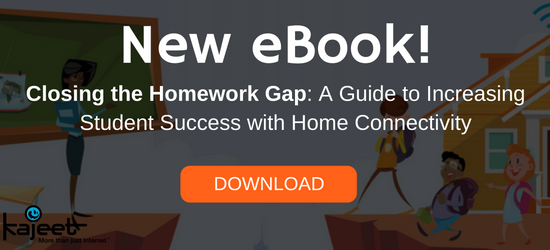Traditional vs. Digital: The Changing Educational Content Landscape
Written by:
Kajeet

What once seemed like the most economical and practical learning tool—printed textbooks—is fast being replaced by digital solutions that provide lower costs, and more easily updated content. Technology is now progressing in leaps and bounds, and our world is evolving with it.
So what does this mean for the future of printed textbooks? And what are the ripple effects on students and schools switching to all digital tools?
The Exciting Shift from Print to Digital Textbooks
As the Internet increasingly takes over different facets of life, it stands to reason that traditional educational methods are in line for a shake-up. Printed textbook information is static, the books are heavy, they’re costly, and they quickly become outdated. Seeing this, textbook manufacturers have moved to producing digital textbooks packed with interactive features, lightweight (or the weight of a student’s mobile device), lower cost, and easily updated with the latest and greatest information.
As illustrated in an article about a high school that’s done away with print textbooks entirely, learning through a digital medium enables students to:
- Search for desired information, just like on Google.
- Instantly access a library of digital textbooks.
- Access learning aids like interactive maps and subject-related speeches and documentaries.
- Interact with homework-help tools like sites that grade not only for grammar, but for sentence structure and repetitive ideas.
At some schools the switch to digital textbooks is making waves in and out of the classroom. Due to the lack of physical textbooks, lockers have become so obsolete that students rarely use them or schools remove them entirely. Architects building new schools even exclude them from building plans. As students increasingly carry school items with them at all times, digital textbooks will lighten their load and provide access to all their materials at any time.
One positive of digital textbooks is undoubtedly their price tag. Digital textbooks eliminate the cost of replacing print textbooks every few years, since new content can be uploaded anytime. Additionally, schools can give students access to open-source educational resources—wells of information free for anyone to use.
Possibly the most impactful effects digital textbooks have had are on learning itself. Print textbooks have immutable information, small margins, and lack engaging characteristics. Some newly developed digital counterparts, however, such as Apple’s iPad textbooks, encourage a personalized learning experience.
“[iPad textbooks] encourage…active note-taking; demand…exploration; [and] create a kind of kaleidoscopic experience: video, text, audio, all whirring and whirling into each other in a self-guided tour of history or chemistry or biology. They invite students to create learning environments that, though standardized on one level, are, on another, uniquely theirs.”
With schools moving to adopt digital textbooks, are there “pros” and “cons” to consider as they make the switch from print?
Print vs. Digital: Research Shows the Pros and Cons
You might be tempted to think the act of studying a printed text—flipping pages, highlighting and scribbling notes, and folding corners down doesn’t contribute to greater learning comprehension—but new findings indicate it might. According to a Washington Post article, research shows readers tend to skim text on screens, leading to distractions and decreased comprehension; but, when reading printed text, remember more key information because of physical page and text characteristics—e.g. if the paragraph is particularly long or the page has a smudge in the corner.
The article also notes, “readers spend a little more than one minute on Web pages, and only 16 percent of people read word-by-word” – a problem as readers try to consume longer pieces of text on-screen.
Lastly, the article points out survey responses show 90 percent of students will multi-task while reading on-screen, but just one percent will multi-task while reading hard copy text. A singular focus while reading printed textbooks might contribute to increased learning comprehension.
But before you throw in the towel on digital learning, consider the conclusions other studies have reached. A Business Insider article synthesized information from several studies on the print vs. digital debate, revealing interesting results:
- Students overwhelmingly prefer to read on digital mediums.
- They read significantly faster online than in print.
- For general questions (like understanding the main idea of the text) the medium does not matter.
In spite of varied research, school districts continue to see the positive aspects of adopting digital textbooks over continuing to use print. Before making the transition, there are several things to keep in mind.
Factors to Consider When Adopting Digital Textbooks
School districts who want to make the switch from print to digital textbooks have several potential hurdles to overcome. First, states generally only change textbooks on 7-to-10 year cycles, which means if a print textbook was purchased last year, convincing officials to spend money this year on new digital technology and textbooks might be a challenge.
Second, the cost of laptops and tablets has gone down drastically in the past decade, but making the case for the extra expense these pose could take some work.
Third, some students may not have Internet access at home. This is a significant problem, as these students can miss out on several hours’ worth of study each night compared to their peers who can log onto the Internet to access textbooks and educational resources. There are tools, however, to remedy this problem such as Kajeet SmartSpot® devices, filtered Wi-Fi hotspots. As more and more school districts examine the costs and benefits of making the switch from print to digital textbooks, equal access to the Internet is a top-of-mind concern.
If your school or district is exploring the change to digital textbooks, contact us today and we will work together to close the Homework Gap between your students who have Internet access and those who don’t.


